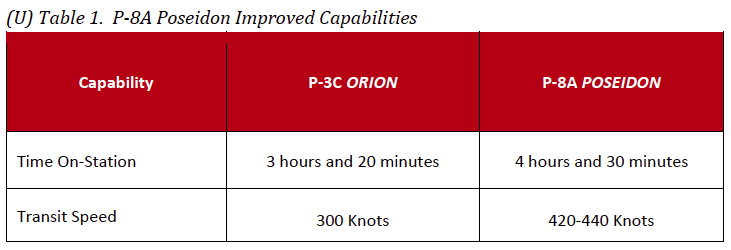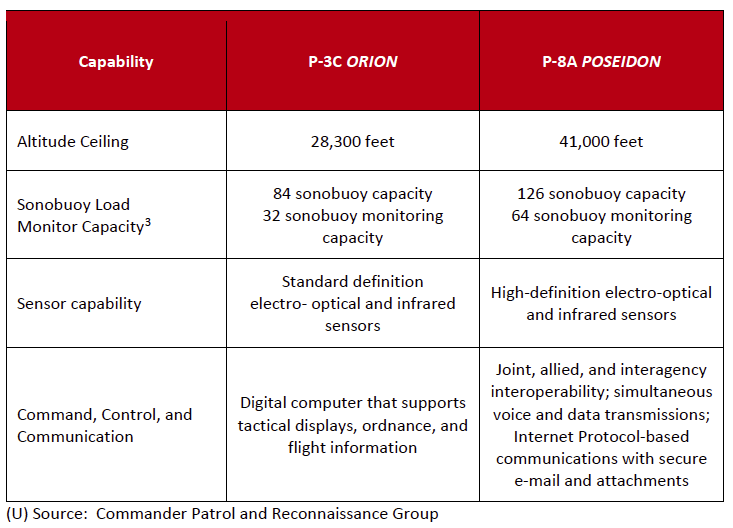The following is the May 19, 2021 Department of Defense Inspector General investigation, Evaluation of the Readiness of the U.S. Navy’s P-8A Poseidon Aircraft to Meet the U.S. European Command’s Anti-Submarine Warfare Requirements.
From the Report
The objective of this evaluation was to determine whether the readiness of the U.S. Navy’s P-8A Poseidon fleet met the anti-submarine warfare (ASW) requirements of the U.S. European Command (USEUCOM).
Background
The P-8A Poseidon is a multi-mission maritime aircraft. It is primarily used by Theater Commanders to conduct ASW operations to deny the enemy the effective use of its submarines against the U.S. and its allies. The Navy began developing and acquiring the P-8A Poseidon in April 2000 to replace its P-3C Orion fleet, which entered Navy service in 1962. In FY 2019, the estimated total acquisition cost for the Navy’s P 8A Poseidon fleet was $35 billion, and the estimated total operation and sustainment cost for the Navy’s P-8A Poseidon fleet was $55 billion. As of December 2019, the Navy planned for at least 117 P-8A Poseidon aircraft.
The P-8A Poseidon is a militarized variant of the Boeing 737 commercial aircraft, with system modifications to support the Navy maritime patrol mission requirements. The Navy developed the P-8A Poseidon to meet its need for rapid-response and long-range search capabilities. The Navy also needed an aircraft that could work independently or in conjunction with carrier strike groups and other joint and allied assets to ensure a maritime area free of surface and subsurface threats.

Table 1 demonstrates the P-8A Poseidon’s capabilities compared to the P-3C Orion.
The Navy plans to complete the transition from the P-3C Orion to the P-8A Poseidon in FY 2022. The Navy will use a mix of P-8A and P-3C aircraft until it completes its transition to the P-8A. As of October 13, 2020, the Navy’s maritime patrol aircraft inventory included 9 P-3C Orion and 104 P 8A Poseidon aircraft assigned to Maritime Patrol Reconnaissance Aircraft (MPRA) patrol squadrons.
USEUCOM Anti-Submarine Warfare Mission
In its area of responsibility (AOR), USEUCOM faces the Russian Navy; specifically, the Russian Northern Fleet. According to the Defense Intelligence Agency, the Northern Fleet is Russia’s most capable naval force, and it operates technologically-advanced ballistic missile submarines that can reach targets in the United States. The Northern Fleet also operates attack submarines that can destroy surface, subsurface, and land targets. The U.S. Naval Forces Europe-Africa/U.S. Sixth Fleet Deputy Commander for Theater Undersea Warfare stated that the U.S. deploys a range of assets to conduct ASW in the North Atlantic, consisting of aircraft, surface ships, submarines, and integrated underwater surveillance systems. Additionally, he stated that, with its improved capabilities, the P-8A Poseidon is the Navy’s primary air asset to effectively counter Russia’s most technologically advanced submarines capabilities, the P-8A Poseidon is the Navy’s primary air asset to effectively counter Russia’s most technologically advanced submarines.
[REDACTED] The officer-in-charge of the Sigonella Aviation Support Division (ASD) stated that Naval Air Station (NAS) Sigonella is the primary deployment site for P-8A Poseidon aircraft in the USEUCOM AOR.
To determine whether the readiness of the U.S. Navy’s P-8A Poseidon fleet met USEUCOM’s ASW requirements, we collected Navy mission capability data and feedback from the Naval Air Systems Command (NAVAIRSYSCOM), Naval Supply Systems Command Weapon Systems Support (NAVSUP WSS), and P-8A Poseidon wing and squadron personnel from the Navy’s CPRG in the United States and USEUCOM area of operations. Specifically, we collected and reviewed the daily aircraft mission capability data of the entire P-8A Poseidon aircraft fleet. We also collected and reviewed the mission capability data for the deployed P-8A Poseidon aircraft in support of USEUCOM’s daily ASW requirements over an 18-month period from October 2018 through March 2020.
Download the document here.






